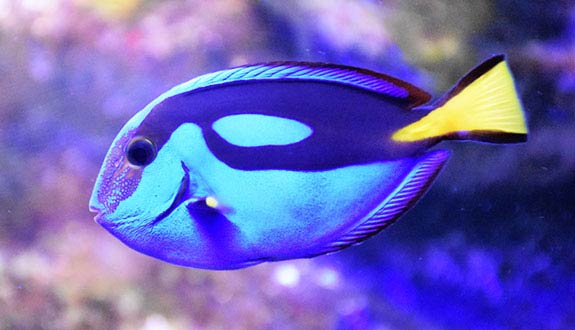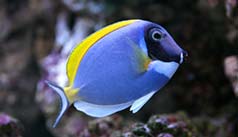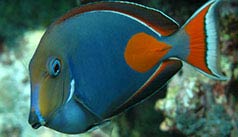

Alternative species (click on the thumbnail to see the card)
Names
Scientific name
Paracanthurus hepatus
Teuthis hepatus
Acanthurus hepatus
Acanthurus theuthis
Paracanthurus theuthis
Common name
Palette surgeonfish
Blue Tang
Blue Surgeonfish
Flagtail surgeonfish
Wedgetail surgeonfish
Paletten Doktorfisch (DE)
Origin

Origin: South Pacific, Indian Ocean
Natural habitat: coral reefs
Dimorphism

The male is bigger
Group

Acanthuridae
Volume

360 L / 80 imp gal / 95 US gal for 1
1000 L /220 imp gal / 265 US gal for 3 and +
Parameters

T°: 23 à 26°C or 73 to 79°F
pH: 7.5 to 8.5
Density: 1021 to 1026
Difficulty

Average
Size

25 cm (10 inches)
Longevity

10 to 25 years
Living zone
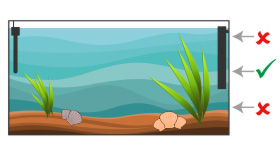
Middle
Individuals
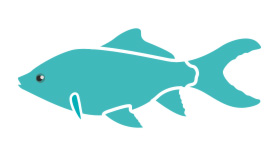
1 or group
Food
How to feed the Paracanthurus?
Food
How to feed the Paracanthurus?
Omnivorous, with a vegetarious tendency, it is a grazer of seaweed. Even if your aquarium contains seaweed, regularly offer fresh or dried seaweed (for example food seaweed used in Japanese food). Also bet on glitter or granules enriched with spirulina. You can also give your fish salad, spinach or boiled broccoli, but these foods are poorer and have less nutritional value.
Do not hesitate to give also small live prey, such as Artemia for example.
Finally, for a complete diet, use frozen foods enriched with vitamins.
For the frequency, do not hesitate to regularly feed your fish (several times a day) because it can quickly weaken if it is not properly fed, or in insufficient quantities.
Behavior
What kind of behavior does the Palette Paracanthurus have?
Behavior
What kind of behavior does the Paracanthurus have?
The Blue Surgeonfish is rather fearful, even scared. It is generally quite calm and swims rather slowly. But do not be fooled! In case of danger, it is able to swim very quickly!
You will sometimes observe your fish lying on its side, for example in case of stress or on the contrary of rest. Do not worry, this posture is normal.
Cohabitation
Who can live with the Paracanthurus?
Cohabitation
Who can live with the Paracanthurus?
The young Blue Surgeonfish live together very well. Once an adult, this cohabitation will depend on the available volume and temper of the fish (some may be more territorial than others). Thus, if space is sufficient, trio or even small group maintenance works well in most cases, because unlike many surgeonfish, this species is not very territorial. Avoid duo maintenance because the dominated could have difficulties to feed and lives normally under the pressure of the dominant.
In order to put the best luck on your side in the cohabitation of your fish, make sure they are introduced into the aquarium at the same time, and that they are the same size.
The Blue Surgeonfish can coexist with other species without difficulty because it is not concerned about the other inhabitants of the aquarium. Be careful though to the aggressiveness of other species, which can sometimes push shy fish to hide constantly, and even to stop feeding. To avoid this, opt for a large volume bin; in a smaller aquarium, prefer calm and peaceful species to coexist with this species. Finally, note that there is no predation of the blue surgeon for small fish or invertebrates.
Breeding
How to breed the Paracanthurus?
Breeding
How to breed the Paracanthurus?
Some breeding displays have been observed in the aquarium, but do not give rise to spawning. Thus, breeding in captivity is until now impossible.
Juvenile food: zooplankton.
Its aquarium
Which aquarium for the Paracanthurus?
Its aquarium
Which aquarium for the Paracanthurus?
For this good swimmer, the shape of the tank will be rather long. Height does not matter much.
The Blue Surgeonfish will appreciate the aquariums imitating its natural environment. It likes a strong brewing, clear water and well oxygenated. It will be perfectly comfortable in a reef aquarium, and will never damage your corals.
As far as decor is concerned, sand and rocks are essential to its well-being. Seaweed mats in various places can also be interesting because the Blue Surgeonfish will come willingly graze some pieces. In addition, please ensure that the lighting is strong enough to allow the development of algae in these areas.
In order to reassure this stressed fish, arrange a lot of hiding among the rocks and fallback area. You can, for example, offer hard corals with branches of the genus Pocillopora or Acropora that it particularly likes. It will be more serene and therefore more inclined to show itself.
Good To know
Find all additional information!
Good To know
Find all additional information!
The skin of this fish is extremely susceptible to diseases and pest attacks. For example, it shows a certain vulnerability to the white spot disease. Moreover, check the condition of the skin of the fish at the time of your purchase, this will save you from starting with an already weakened individual.
It is common for the Blue Surgeonfish to have white dots. It is not necessarily useful to treat, things should return to order if the maintenance and the feeding are adapted. Give it vitamins to promote its healing.
Because of this particular sensitivity and its nutritional requirements, beginners will avoid the maintenance of this species which can be a little tricky. With a little more experience, maintenance should not be a major problem!
The color of the Blue Surgeonfish varies according to its age: young, it is a beautiful blue. Growing up, this color becomes lighter and gives way to yellow or white.
Young fish are easier to acclimatize than adults.
This fish does not support quarantine. In case of illness, prefer adding a UV lamp to your filtration system than isolating the fish.
Its caudal spines are real fighting weapons! It is also because of these blades, similar to scalpels, that it owes its name of «surgeon». They are covered with venomous mucus that can cause severe pain.
Yours photos!

By Encyclo-Caro

By Encyclo-Caro

By Encyclo-Caro

By Encyclo-Caro
Comments
Sort by:
Please login to post comments
